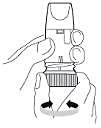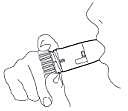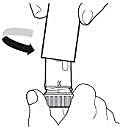100 micrograms / dose, 200 micrograms / dose and 400 micrograms / dose of inhaled powder
budesonide
What Pulmicort Turbohaler is and what it is used for
Pulmicort Turbohaler is used as a regular treatment for asthma.
Pulmicort Turbohaler dampens and prevents inflammation in the airways in asthma.
Pulmicort Turbohaler should be used regularly for preventive purposes – not to provide quick relief in acute problems. It may take a few weeks before you get the full effect of the treatment.
What you need to know before using Pulmicort Turbohaler
Do not use Pulmicort Turbohaler
- if you are allergic to budesonide.
Warnings and cautions
Tell your doctor if you:
- have or have had liver disease or problem with the liver,
- have pulmonary tuberculosis (active or inactive),
- has a fungal or viral infection of the respiratory tract.
If you switch from cortisone tablets to Pulmicort Turbohaler, in some cases your previous allergic problems such as runny nose and eczema may return. You may also experience fatigue, headaches, muscle, and joint pain, as well as occasional nausea and vomiting. This is because the total amount of cortisone in the body is reduced by treating the disease locally in the lungs. These problems disappear after some time of treatment.
You should rinse your mouth with water after each dosing session, to minimize the risk of getting a fungal infection in the oral cavity and throat. Contact a doctor if you get symptoms of a fungal infection.
In rare cases, with long-term treatment with budesonide, growth in children and adolescents may decrease. If your child is using this medicine for a long time, your doctor will usually want to check your child’s height regularly.
If your asthma worsens, consult a doctor. This may mean that one dose needs to be changed or that you need another treatment.
In the event of an acute asthma attack, you should use your fast-acting asthma medicine.
Contact a doctor if you experience blurred vision or other visual disturbances.
Children and young people
Your doctor will regularly check the height of children receiving long-term treatment with Pulmicort. If growth slows, treatment should be re-evaluated
Other medicines and Pulmicort Turbohaler
Tell your doctor or pharmacist if you are taking, have recently taken, or might take any other medicines.
Some medicines may affect or be affected by treatment with Pulmicort Turbohaler, such as those containing:
- ketoconazole or itraconazole (found in antifungal agents).
- saquinavir, indinavir, ritonavir, nelfinavir, amprenavir, lopinavir, fosamprenavir, atazanavir or tipranavir (so-called HIV protease inhibitors used against HIV ).
Pulmicort Turbohaler can affect a test performed to check the function of the pituitary gland, ACTH stimulation test, which can give incorrectly low values.
Pregnancy and breastfeeding
Experience with use during pregnancy does not indicate an increased risk of malformations. However, talk to your doctor before using Pulmicort Turbohaler during pregnancy, as your asthma severity may change and treatment may need to be adjusted.
Budesonide passes into breast milk. However, at therapeutic doses of Pulmicort Turbohaler, the risk of effects on breast-fed infants is considered unlikely. Pulmicort Turbohaler can be used during breastfeeding.
If you are pregnant or breastfeeding, think you may be pregnant, or are planning to have a baby, ask your doctor or pharmacist for advice before taking this medicine.
Driving and using machines
Pulmicort Turbohaler does not affect your ability to drive or use machines.
How to use Pulmicort Turbohaler
Always use this medicine exactly as your doctor has told you. Ask your doctor or pharmacist if you are unsure.
Your doctor will decide on a dose to suit you.
The number of dosing times varies depending on how severe your asthma is.
You should use Pulmicort Turbohaler regularly, that is, every day, even if you have no symptoms.
Pulmicort Turbohaler is powered solely by your inhalation. The medicine accompanies the inhaled air down to the airways. It is therefore important that you inhale deeply and strongly when taking your dose, see the user manual.
Note that the amount of the drug is so small that dose one can be very difficult to perceive.
You may not feel any taste or otherwise notice the medicine. If you follow the instructions for use, you can still be sure that you have inhaled dose one.
User manual

When about 20 doses are left, a red mark appears in the window of the dose indicator. When the mark reaches the lower edge of the window, all doses are exhausted and the inhaler should be discarded. There may be medication left in the inhaler, but not enough to give you an additional dose.
How to prepare your new Pulmicort Turbohaler inhaler
Before using your new Pulmicort Turbohaler inhaler for the first time, you must prepare it for use as follows:
- Unscrew and lift off the protective sleeve.
- Hold your Pulmicort Turbohaler inhaler upright with the knob down.
- Turn the knob as far as it will go in one direction. Then turn it as far as it will go in the other direction (it does not matter which direction you turn first). You should hear a clicking sound.
- Repeat this by turning the knob in both directions.
- Your Pulmicort Turbohaler inhaler is now ready for use.
How to take a dose of Pulmicort Turbohaler
1. Unscrew the protective sleeve.

2. Hold the inhaler upright with the knob down. Do not hold the nozzle. Feed a dose by first turning the knob in one direction as far as it will go and then back (it does not matter which direction you turn first). You should hear a clicking sound. If you are unsure if you have delivered a dose, then deliver a new dose. You can never take more than one dose at a time from the inhaler.

Exhale (but not through the inhaler).
- Put the nozzle between your teeth and close your lips around the nozzle.
- Inhale deeply and strongly through the mouth. Do not bite or chew on the nozzle.
- Remove the inhaler from your mouth before exhaling. If you are going to take several doses at a time, repeat steps 2-3.

4. Screw on the protective sleeve. Rinse your mouth with water after each dosing session, so that you can remove any medicine that may remain in your mouth.

Remember
- Hold the inhaler upright with the knob down when feeding a dose .
- Do not exhale through the mouthpiece.
- Always screw the protective sleeve firmly after each use.
- Do not attempt to remove or twist the nozzle. It should remain.
- Clean the nozzle regularly (once a week) with a soft paper towel. Never use water or other liquids.
- When the red mark reaches the lower edge of the dose indicator window, all doses are exhausted and the inhaler should be discarded. There may be medication left in the inhaler, but not enough to give you an additional dose .
- The sound heard when you shake the inhaler is not medicine but comes from the desiccant in the knob.
- Do not use your Turbohaler if it is damaged or if the nozzle has come loose.
If you take more Pulmicort Turbohaler than you should
If you have ever used a larger dose than your doctor prescribed, you are unlikely to experience any side effects . However, if you use a larger dose than your doctor prescribes for a longer period (months), there is a risk that you will experience side effects .
If you have ingested too much medicine or if e.g. If a child has ingested the medicine by mistake, contact a doctor or hospital for risk assessment and advice.
It is important that you take a dose as stated on the label on the package or as your doctor has informed you. Do not increase or decrease the dose without consulting a doctor.
If you forget to take Pulmicort Turbohaler
If you forget to take a dose , take the next dose as usual.
Possible side effects
Like all medicines, this medicine can cause side effects , although not everybody gets them.
Serious side effects are
Common (may affect up to 1 in 10 people): pneumonia (in COPD patients).
Tell your doctor if you have any of the following symptoms while taking Pulmicort Turbohaler as they may be symptoms of pneumonia:
- fever or chills
- increased mucus production, changed color of the mucus
- increased cough or increased difficulty breathing.
Rare (may affect up to 1 in 1,000 people ) : angioedema , anaphylactic reactions, bronchospasm (bronchospasm).
Stop taking Pulmicort Turbohaler and contact your doctor immediately if you get any of the following symptoms of angioedema:
- swelling of the face, tongue or throat
- difficulty swallowing
- hives and difficulty breathing.
Other side effects ar
Common ( may affect up to 1 in 10 people): Throat irritation, cough, fungal infection of the oral cavity and throat.
Uncommon (may affect up to 1 in 100 people): Cataracts (clouding of the lens of the eye), blurred vision, depression, anxiety, muscle cramps, tremors.
Rare (may affect up to 1 in 1,000 people): Immediate and delayed hypersensitivity reactions such as hives and other skin rashes, contact dermatitis and corticosteroid effects (see below). Bruising, dysphonia (speech difficulties), hoarseness, restlessness, anxiety, behavioral disorders (occurs predominantly in children).
Has been reported (occurs in an unknown number of users) : Cataracts (increased pressure in the eye), sleep problems, aggression, feeling very upset and / or irritability.
Inhaled corticosteroids can affect the normal production of steroid hormones in the body, especially if you use high doses for a long time. The effects include:
- Changes in bone mineral density (thinning of the skeleton).
- Cataracts (cloudiness of the eye lens).
- Cataracts (increased pressure in the eye).
- A subdued growth rate in children and adolescents.
- An effect on the adrenal glands (a small gland that sits next to the kidney).
The likelihood of these effects occurring is much less for inhaled corticosteroids than for cortisone tablets.
How to store Pulmicort Turbohaler
- Keep this medicine out of the sight and reach of children.
- Do not store above 30 ° C. Store the inhaler with the protective sleeve attached.
- Do not use this medicine after the expiry date which is stated on the inhaler and carton after EXP. The expiration date is the last day of the specified month.
- Medicines should not be disposed of via wastewater or household waste. Ask your pharmacist how to dispose of medicines no longer required. These measures will help to protect the environment. Spent disposable inhalers should be taken to a pharmacy, as a small amount of medicine is always left in the inhaler.
Contents of the pack and other information
Content declaration
- The active substance is budesonide. One dose ( inhalation ) contains 100 micrograms, 200 micrograms and 400 micrograms budesonide, respectively.
What the medicine looks like and contents of the pack
Each inhaler contains 200 doses.
Marketing Authorization Holder and Manufacturer
AstraZeneca AB, 151 85 Södertälje.